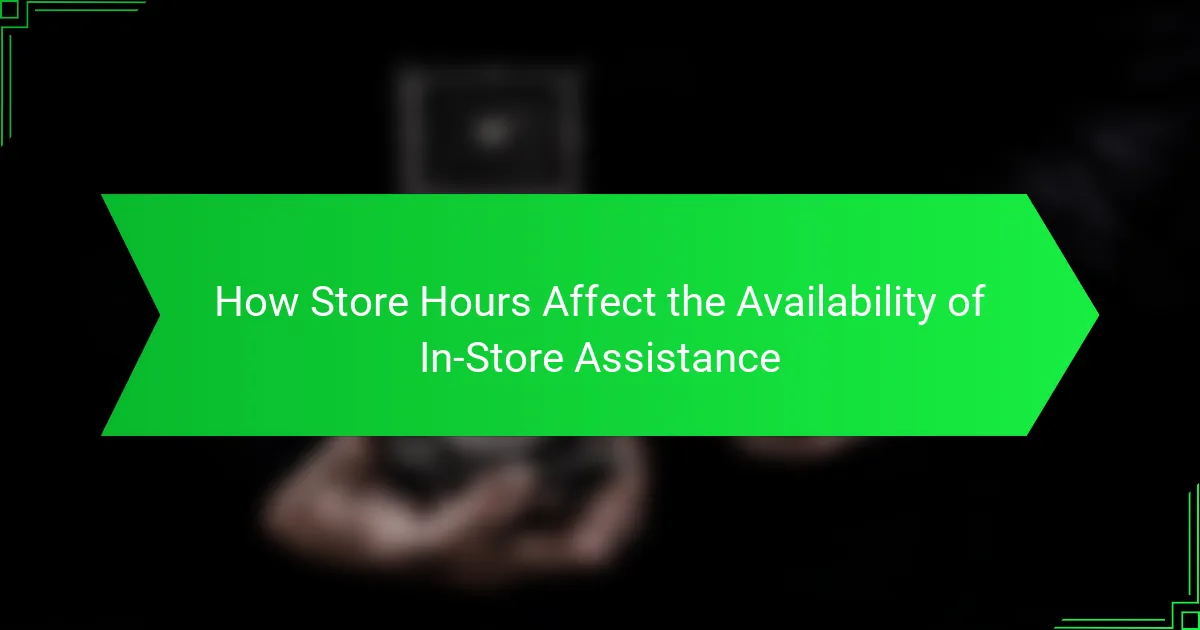Store hours play a crucial role in determining the availability of in-store assistance, directly impacting customer experience. When store hours are aligned with peak shopping times, customers benefit from immediate support, enhancing their overall satisfaction and loyalty. Conversely, limited hours can restrict access to assistance, especially during busy periods, making it essential for retailers to optimize their schedules.

How do store hours impact in-store assistance availability?
Store hours significantly influence the availability of in-store assistance, as they determine when staff are present to help customers. Extended hours generally provide more opportunities for assistance, while reduced hours can lead to limited support during peak shopping times.
Extended hours increase customer support
When stores offer extended hours, they typically have more staff available to assist customers, which enhances the overall shopping experience. For example, a store open from 9 AM to 9 PM may have staff available during all hours, allowing for better customer service.
Additionally, longer hours can cater to different customer schedules, such as those who work late or prefer shopping during off-peak times. This flexibility can lead to increased customer satisfaction and loyalty.
Reduced hours limit staff availability
Stores with reduced hours often struggle to provide adequate in-store assistance, especially during busy periods. For instance, a shop that closes early may not have enough staff on hand to address customer needs, leading to longer wait times and potential frustration.
Moreover, limited hours can result in fewer opportunities for staff training, which may affect the quality of assistance provided. Customers may find that they receive less knowledgeable support during these times.
Peak hours affect assistance quality
During peak hours, such as weekends or holidays, the demand for assistance often exceeds the available staff, leading to a decline in service quality. Customers may experience longer wait times and less personalized attention, which can detract from their shopping experience.
To mitigate this, stores can consider adjusting their staffing levels based on expected traffic patterns. For example, having additional staff during known busy periods can help maintain a high level of customer support.

What are the best practices for scheduling store hours?
Best practices for scheduling store hours involve aligning operational times with customer needs and preferences. This ensures that in-store assistance is available when shoppers are most likely to visit, enhancing their overall experience.
Align hours with customer shopping patterns
Understanding customer shopping patterns is crucial for effective store hour scheduling. Analyze peak shopping times, which often occur during evenings and weekends, to ensure staff availability aligns with these periods. For example, if data shows that most customers shop after work hours, consider extending evening hours to accommodate them.
Additionally, consider the demographics of your customer base. Families may prefer weekend shopping, while young professionals might favor late-night hours. Tailoring store hours to these patterns can significantly improve customer satisfaction and increase sales.
Consider local events and holidays
Local events and holidays can greatly influence shopping behavior, so it’s essential to adjust store hours accordingly. For instance, during major holidays like Christmas or Black Friday, extending hours can capture increased foot traffic. Conversely, during local festivals or events, consider adjusting hours to avoid staffing during low-traffic periods.
Stay informed about local calendars and community events to proactively plan your store hours. This not only helps in maximizing sales but also shows customers that you are engaged with the community, fostering loyalty and repeat business.

How can e-commerce benefit from in-store assistance hours?
E-commerce can significantly benefit from in-store assistance hours by providing customers with immediate access to help when they need it. This availability enhances the shopping experience and builds trust, ultimately leading to higher satisfaction and loyalty.
Improved customer experience
In-store assistance hours allow customers to receive personalized help, which can enhance their overall shopping experience. When shoppers know they can get immediate answers to their questions or assistance with product selection, they feel more confident in their purchases.
For example, a customer browsing a website may hesitate to buy a product without understanding its features. If they can access in-store assistance during specific hours, they can clarify doubts, leading to a smoother and more satisfying shopping journey.
Increased conversion rates
Having in-store assistance hours can lead to increased conversion rates as customers are more likely to complete purchases when they receive timely support. When shoppers encounter obstacles, such as technical issues or product inquiries, immediate help can resolve these concerns and encourage them to finalize their transactions.
Retailers can track conversion rates during hours of in-store assistance to assess the impact. For instance, if conversion rates are significantly higher during these hours compared to off-hours, it indicates that customer support is a crucial factor in driving sales.

What tools can optimize store hour management?
Effective store hour management can be enhanced through various tools that streamline scheduling and gather customer insights. Utilizing the right software can lead to better staffing decisions and improved customer service availability.
Scheduling software like When I Work
Scheduling software, such as When I Work, allows managers to create and manage employee schedules efficiently. These tools often include features like shift swapping, availability tracking, and notifications, which help ensure that the right number of staff are present during peak hours.
When selecting scheduling software, consider ease of use, integration with existing systems, and mobile accessibility for employees. This can significantly reduce scheduling conflicts and enhance overall operational efficiency.
Customer feedback platforms
Customer feedback platforms enable businesses to gather insights directly from shoppers regarding their in-store experiences. Tools like SurveyMonkey or Google Forms can help identify peak times and customer preferences, allowing for adjustments in store hours to better meet demand.
To maximize the effectiveness of feedback platforms, ensure that surveys are concise and incentivize participation. Analyzing feedback regularly can reveal patterns that inform staffing needs and operational hours, ultimately improving customer satisfaction.

How do competitors manage their store hours?
Competitors in the retail sector often adopt varied store hours to enhance customer access and optimize in-store assistance. By aligning their hours with consumer demand, they can improve service availability and meet shopper needs more effectively.
Case study: Walmart’s flexible hours
Walmart employs flexible store hours to cater to a broad customer base, often opening early and closing late. This strategy allows them to provide in-store assistance during peak shopping times, such as evenings and weekends, when customer traffic is highest.
For instance, many Walmart locations operate 24 hours, enabling customers to receive assistance at any time. This flexibility not only enhances customer satisfaction but also allows Walmart to manage staffing levels efficiently, ensuring adequate support during busy periods.
Comparison with Target’s staffing strategies
Target typically maintains more standardized hours compared to Walmart, often opening later and closing earlier. This approach can limit in-store assistance availability during peak shopping hours, particularly in the evenings when many customers prefer to shop.
Target focuses on maximizing staff efficiency during its operating hours, often employing a higher staff-to-customer ratio during peak times. This strategy aims to ensure that customers receive prompt assistance, even if the store hours are not as extensive as those of competitors like Walmart.

What are the future trends in store hours and assistance?
Future trends indicate a significant shift towards more flexible store hours and enhanced in-store assistance, driven by customer demand for convenience and immediate support. Retailers are increasingly adopting strategies that prioritize 24/7 availability and the integration of technology to streamline assistance.
Shift towards 24/7 customer support
The trend towards 24/7 customer support reflects a growing expectation for immediate assistance at any time. Retailers are extending their hours to accommodate customers’ busy schedules, allowing for shopping and support outside traditional business hours.
This shift often involves staffing adjustments, where businesses may employ more part-time workers or utilize remote assistance options to ensure coverage. For example, a store may operate physically from 9 AM to 9 PM but offer online chat support around the clock.
Integration of AI in scheduling
Artificial intelligence is increasingly being integrated into scheduling systems to optimize in-store assistance. AI can analyze customer traffic patterns and predict peak times, enabling retailers to allocate staff more effectively and ensure that assistance is readily available when needed.
For instance, an AI system might suggest increasing staff during weekend afternoons when foot traffic is highest, while reducing hours during slower periods. This not only improves customer service but also helps manage labor costs efficiently.
